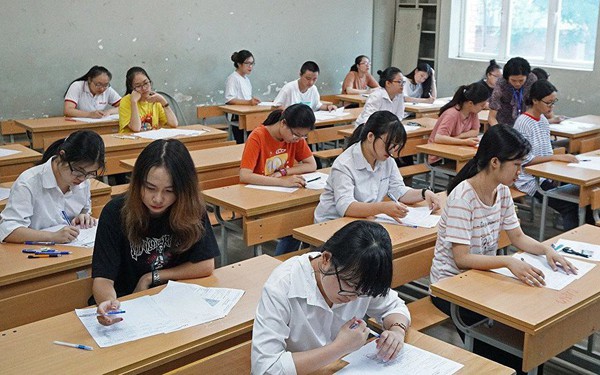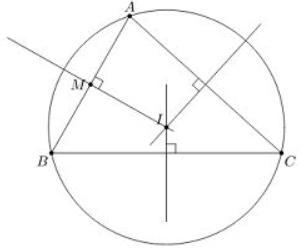GIỚI HẠN CỦA HÀM SỐ
A/ LÝ THUYẾT
I/ Định nghĩa giới hạn hữu hạn của hàm số
+ Với ${{x}_{n}}\in K\backslash ({{x}_{0}})$ và khi ${{x}_{n}}$ dần tới ${{x}_{0}}$ thì ta có $f({{x}_{n}})$ dần về một số L xác định.
+ Kí hiệu: $\underset{x\to {{x}_{0}}}{\mathop{\lim }}\,f(x)=L$
+ Số L được gọi là giới hạn của hàm số $y=f({{x}_{0}})$ khi x dần tới ${{x}_{0}}$ với dãy $({{x}_{n}})$ bất kì.
+ Cho hàm số $y=f(x)$ xác định trên khoảng $({{x}_{0}};b)$ , số L được gọi là giới hạn phải của hàm số $y=f(x)$ khi x tiến tới ${{x}_{0}}$ nếu với dãy số $({{x}_{n}})$ bất kì, .png) và
và .png) , thì ta có
, thì ta có .png)
Kí hiệu: $\underset{x\to x_{0}^{+}}{\mathop{\lim }}\,f(x)=L$
+ Cho hàm số $y=f(x)$ xác định trên khoảng $(a;{{x}_{0}})$ , số L được gọi là giới hạn trái của hàm số $y=f(x)$ khi x tiến tới ${{x}_{0}}$ nếu với dãy số $({{x}_{n}})$ bất kì, $a>{{x}_{o}}>{{x}_{n}}$ và ${{x}_{n}}\to {{x}_{0}}$ , thì ta có $f({{x}_{n}})\to L$
Kí hiệu: $\underset{x\to x_{0}^{-}}{\mathop{\lim }}\,f(x)=L$
II/ Giới hạn hữu hạn và giới hạn vô cực
1/ Giới hạn hữu hạn
a/ Giới hạn đặc biệt
+ $\underset{x\to {{x}_{0}}}{\mathop{\lim }}\,x={{x}_{o}}$
+ $\underset{x\to {{x}_{0}}}{\mathop{\lim }}\,c=c$ (c là một hằng số)
b/ Định lý
+ Nếu $\underset{x\to {{x}_{0}}}{\mathop{\lim }}\,f(x)=L$ và $\underset{x\to {{x}_{0}}}{\mathop{\lim }}\,g(x)=M$ thì:
$\underset{x\to {{x}_{0}}}{\mathop{\lim }}\,\left[ f(x)+g(x) \right]=L+M$
$\underset{x\to {{x}_{0}}}{\mathop{\lim }}\,\left[ f(x)g(x) \right]=L-M$
$\underset{x\to {{x}_{0}}}{\mathop{\lim }}\,\left[ f(x).g(x) \right]=LM$
$\underset{x\to {{x}_{0}}}{\mathop{\lim }}\,\left[ \frac{f(x)}{g(x)} \right]=\frac{L}{M}$ $\left( M\ne 0 \right)$
+ Nếu $f(x)\ge 0$ và $\underset{x\to {{x}_{0}}}{\mathop{\lim }}\,f(x)=L$ thì $L\ge 0$ và $\underset{x\to {{x}_{0}}}{\mathop{\lim }}\,\sqrt{f(x)}=\sqrt{L}$
+ Nếu $\underset{x\to {{x}_{0}}}{\mathop{\lim }}\,f(x)=L$ thì $\underset{x\to {{x}_{0}}}{\mathop{\lim }}\,\left| f(x) \right|=\left| L \right|$
c/ Giới hạn một bên
$\underset{x\to {{x}_{0}}}{\mathop{\lim }}\,f(x)=L\Leftrightarrow \underset{x\to x_{0}^{+}}{\mathop{\lim }}\,f(x)=\underset{x\to x_{0}^{-}}{\mathop{\lim }}\,f(x)=L$
2/ Giới hạn vô cực, giới hạn ở vô cực
a/ Giới hạn đặc biệt
+ $\underset{x\to +\infty }{\mathop{\lim }}\,{{x}^{k}}=+\infty $
+ \[\underset{x\to -\infty }{\mathop{\lim }}\,{{x}^{k}}=+\infty \] nếu k chẵn; \[\underset{x\to -\infty }{\mathop{\lim }}\,{{x}^{k}}=-\infty \] nếu k lẻ
+ $\underset{x\to \pm \infty }{\mathop{\lim }}\,c=c$ (c là một hằng số)
+ $\underset{x\to \pm \infty }{\mathop{\lim }}\,\frac{c}{{{x}^{k}}}=0$ (c là một hằng số)
+ $\underset{x\to {{0}^{-}}}{\mathop{\lim }}\,\frac{1}{x}=-\infty $ ; $\underset{x\to {{0}^{+}}}{\mathop{\lim }}\,\frac{1}{x}=+\infty $
+ $\underset{x\to {{0}^{-}}}{\mathop{\lim }}\,\frac{1}{\left| x \right|}=\underset{x\to {{0}^{+}}}{\mathop{\lim }}\,\frac{1}{\left| x \right|}=+\infty $
b/ Định lý
+ Nếu $\underset{x\to {{x}_{0}}}{\mathop{\lim }}\,f(x)=L\ne 0$ và $\underset{x\to {{x}_{0}}}{\mathop{\lim }}\,g(x)=\pm \infty $ thì:
$\underset{x\to {{x}_{0}}}{\mathop{\lim }}\,f(x)g(x)=+\infty $ khi L và $\underset{x\to {{x}_{0}}}{\mathop{\lim }}\,g(x)$ cùng dấu
$\underset{x\to {{x}_{0}}}{\mathop{\lim }}\,f(x)g(x)=-\infty $ khi L và $\underset{x\to {{x}_{0}}}{\mathop{\lim }}\,g(x)$ trái dấu
$\underset{x\to {{x}_{0}}}{\mathop{\lim }}\,\frac{f(x)}{g(x)}=0$ nếu $\underset{x\to {{x}_{0}}}{\mathop{\lim }}\,g(x)=\pm \infty $
$\underset{x\to {{x}_{0}}}{\mathop{\lim }}\,\frac{f(x)}{g(x)}=+\infty $ nếu $\underset{x\to {{x}_{0}}}{\mathop{\lim }}\,g(x)=0$ và $L.g(x)>0$
$\underset{x\to {{x}_{0}}}{\mathop{\lim }}\,\frac{f(x)}{g(x)}=-\infty $ nếu $\underset{x\to {{x}_{0}}}{\mathop{\lim }}\,g(x)=0$ và $L.g(x)<0$
+ Khi tính các giới hạn có một trong các dạng vô định: $\frac{0}{0}$ ; $\frac{\infty }{\infty }$ , $\infty -\infty $ , $0.\infty $ thì ta phải tìm cách khử dạng vô định.
B/ VÍ DỤ
VD 1: Kết quả nào dưới đây là sai?
A.$\underset{x\to 3}{\mathop{\lim }}\,\frac{{{x}^{2}}-4x+3}{x-3}=2$
B.$\underset{x\to 2}{\mathop{\lim }}\,\frac{{{x}^{2}}+x-6}{{{x}^{2}}-4}=\frac{5}{4}$
C.$\underset{x\to 1}{\mathop{\lim }}\,\frac{4{{x}^{6}}-5{{x}^{5}}+x}{{{(1-x)}^{2}}}=10$
D.$\underset{x\to 4}{\mathop{\lim }}\,\frac{{{x}^{2}}-16}{{{x}^{2}}+x-20}=\frac{9}{8}$
Giải:
Chú ý: Ở VD này anh sẽ giải chi tiết cho các em, từ VD sau trở đi, anh sẽ hướng dẫn các em cách bấm máy cho nhanh!
Ta kiểm tra từng đáp án
A.$\underset{x\to 3}{\mathop{\lim }}\,\frac{{{x}^{2}}-4x+3}{x-3}=\underset{x\to 3}{\mathop{\lim }}\,\frac{(x-3)(x-1)}{x-3}=\underset{x\to 3}{\mathop{\lim }}\,(x-1)=2$ => A đúng
B.$\underset{x\to 2}{\mathop{\lim }}\,\frac{(x+3)(x-2)}{(x+2)(x-2)}=\underset{x\to 2}{\mathop{\lim }}\,\frac{x+3}{x+2}=\frac{5}{4}$ => B đúng
C.$\underset{x\to 1}{\mathop{\lim }}\,\frac{4{{x}^{6}}-5{{x}^{5}}+x}{{{(1-x)}^{2}}}=\underset{x\to 1}{\mathop{\lim }}\,\frac{x{{(x-1)}^{2}}(4{{x}^{3}}+3{{x}^{2}}+2x+1)}{{{(1-x)}^{2}}}$
$=\underset{x\to 1}{\mathop{\lim }}\,\left[ x\left( 4{{x}^{3}}+3{{x}^{2}}+2x+1 \right) \right]=10$ => C đúng
D.$\underset{x\to 4}{\mathop{\lim }}\,\frac{{{x}^{2}}-16}{{{x}^{2}}+x-20}=\underset{x\to 4}{\mathop{\lim }}\,\frac{(x-4)(x+4)}{(x-4)(x+5)}=\underset{x\to 4}{\mathop{\lim }}\,\frac{x+4}{x+5}=\frac{8}{9}$ => D sai
Đáp án D
VD 2: Kết quả nào dưới đây là sai?
A.$\underset{x\to 1}{\mathop{\lim }}\,\frac{{{x}^{3}}-1}{{{x}^{3}}-{{x}^{2}}+x-1}=\frac{3}{2}$
B.$\underset{x\to 3}{\mathop{\lim }}\,\frac{{{x}^{4}}-6{{x}^{2}}-27}{{{x}^{3}}+3{{x}^{2}}+x+3}=-\frac{36}{5}$
C.$\underset{x\to 0}{\mathop{\lim }}\,\frac{(1+x)(1+2x)(1+3x)-1}{x}=5$
D.$\underset{x\to -1}{\mathop{\lim }}\,\frac{{{x}^{5}}+1}{{{x}^{3}}+1}=\frac{5}{3}$
Giải:
Hướng dẫn cách bấm CASIO
A.Các em nhập vào máy $\frac{{{x}^{3}}-1}{{{x}^{3}}-{{x}^{2}}+x-1}$ để ý vì đây là x tiến với 1 nên ta CALC và cho x = 0,9999999999 hoặc 2,00000001 đều được, máy sẽ báo kết quả là 1,5
=> A đúng
B.Tương tự các em nhập vào $\frac{{{x}^{4}}-6{{x}^{2}}-27}{{{x}^{3}}+3{{x}^{2}}+x+3}$ để ý vì đây x tiến tới 3 nên ta CALC và cho x bằng 2,999999999 hoặc 3,00000001 ta thu được kết quả là $-7,2=-\frac{36}{5}$
=> B đúng
C.Tương tự như hai đáp án trên thì nhập vào $\frac{(1+x)(1+2x)(1+3x)-1}{x}$sau đó CALC với x bằng 0,0000001 thì ta thu được kết quả là 6
Ta chọn đáp án C
Nếu muốn chắc chắn hơn thì các em thử đáp án D ra kết quả là -3
VD 3: Tính $\underset{x\to 1}{\mathop{\lim }}\,\frac{\sqrt{2x+7}+x-4}{{{x}^{3}}-4{{x}^{2}}+3}$
A.$\frac{4}{15}$
B.$\frac{2}{5}$
C.$-\frac{4}{15}$
D.$-\frac{2}{5}$
Giải:
*Cách tự luận:
$\underset{x\to 1}{\mathop{\lim }}\,\frac{\sqrt{2x+7}+x-4}{{{x}^{3}}-4{{x}^{2}}+3}=\underset{x\to 1}{\mathop{\lim }}\,\frac{(\sqrt{2x+7}-3)+(x-1)}{(x-1)({{x}^{2}}-3x-3)}$
$=\underset{x\to 1}{\mathop{\lim }}\,\frac{(\sqrt{2x-7}-3)(\sqrt{2x+7}+3)}{(x-1)({{x}^{2}}-3x-3)(\sqrt{2x-7}+3)}+\underset{x\to 1}{\mathop{\lim }}\,\frac{x-1}{(x-1)({{x}^{2}}-3x-3)}$
$=\underset{x\to 1}{\mathop{\lim }}\,\frac{2(x-1)}{(x-1)({{x}^{2}}-3x-3)(\sqrt{2x+7}+3)}+\underset{x\to 1}{\mathop{\lim }}\,\frac{1}{{{x}^{2}}-3x-3}$
$=-\frac{1}{15}-\frac{1}{5}=-\frac{4}{15}$
Đáp án C
*Cách CASIO
Nhập vào máy $\frac{\sqrt{2x+7}+x-4}{{{x}^{3}}-4{{x}^{2}}+3}$ sau có CALC với x bằng 0,99999999 hoặc 1,0000001 ta đều thu được kết quả $-0,266666666666=-\frac{4}{15}$
VD 4: Tính $\underset{x\to 2}{\mathop{\lim }}\,\frac{\sqrt[3]{8x+11}-\sqrt{x-7}}{{{x}^{2}}-3x+2}$
A.$\frac{7}{54}$
B.$\frac{1}{9}$
C.$\frac{4}{27}$
D.$\frac{1}{6}$
Giải:
$\underset{x\to 2}{\mathop{\lim }}\,\frac{\sqrt[3]{8x+11}-\sqrt{x-7}}{{{x}^{2}}-3x+2}=\underset{x\to 2}{\mathop{\lim }}\,\frac{\sqrt[3]{8x+11}-3}{{{x}^{2}}-3x+2}-\underset{x\to 2}{\mathop{\lim }}\,\frac{\sqrt{x-7}-3}{{{x}^{2}}-3x+2}$
$=\underset{x\to 2}{\mathop{\lim }}\,\frac{8(x-2)}{(x-2)(x-1)\left[ {{\left( \sqrt[3]{8x+11} \right)}^{2}}+3\sqrt[3]{8x+11}+9 \right]}-\underset{x\to 2}{\mathop{\lim }}\,\frac{x-2}{(x-2)(x-1)\left( \sqrt{x+7}+3 \right)}$ $=\frac{8}{27}-\frac{1}{6}=\frac{7}{54}$
Đáp án A
C/ BÀI TẬP
Bài 1: Tính $\underset{x\to 1}{\mathop{\lim }}\,\frac{\sqrt[4]{2x-1}+\sqrt[5]{x-2}}{x-1}$
A.$\frac{3}{10}$
B.$\frac{5}{10}$
C.$\frac{7}{10}$
D.$\frac{9}{10}$
Bài 2: Tính $\underset{x\to 1}{\mathop{\lim }}\,\left( \frac{1}{1-x}-\frac{3}{1-{{x}^{3}}} \right)$
A.1
B.-1
C.2
D.-2
Bài 3: Tính $\underset{x\to 2}{\mathop{\lim }}\,\left( \frac{1}{{{x}^{2}}-3x-2}+\frac{1}{{{x}^{2}}-5x+6} \right)$
A.-2
B.2
C.1
D.-1
Bài 4: Tính $\lim (\sqrt{{{x}^{2}}-5x+6}-x)$
A.3
B.$-\frac{5}{2}$
C.$-\frac{5}{3}$
D.-3
Bài 5: Tính $\underset{x\to \frac{\pi }{6}}{\mathop{\lim }}\,\frac{2{{\sin }^{2}}x+\sin x-1}{2{{\sin }^{2}}x-3\sin x+1}$
A.3
B.-3
C.$\frac{1}{3}$
D.$-\frac{1}{3}$
Bài 6: Tính $\underset{x\to \frac{\pi }{3}}{\mathop{\lim }}\,\frac{{{\tan }^{3}}x-3\tan x}{\cos \left( x+\frac{\pi }{6} \right)}$
A.12
B.-12
C.24
D.-24
Bài 7: Tính $\underset{x\to 0}{\mathop{\lim }}\,\frac{\sin (a+2x)-2\sin (a+x)+\sin a}{{{x}^{2}}}$
A.$\sin a$
B.$-\sin a$
C.$\cos a$
D.$-\cos a$
Bài 8: Tính $\underset{x\to 0}{\mathop{\lim }}\,\frac{1-\cos x.\cos 2x.\cos 3x}{1-\cos x}$
A.12
B.16
C.14
D.18
Bài 9: Tính $\underset{x\to 0}{\mathop{\lim }}\,\frac{1-\cos 3x.\cos 5x.\cos 7x}{{{\sin }^{2}}7x}$
A.$\frac{83}{49}$
B.$\frac{83}{98}$
C.$\frac{81}{49}$
D.$\frac{81}{98}$
Bài 10: Tính $\underset{x\to 0}{\mathop{\lim }}\,\frac{1-\sqrt{2{{x}^{2}}+1}}{1-\cos x}$
A.2
B.-2
C.1
D.-1
ĐÁP ÁN
.png)






